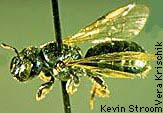
Photo 19: Rose stem girdler
Rose stem girdler (Agrilus aurichalceus)
Identification
 Photo 19: Rose stem girdler |
Scouting
The rose stem girdler larva feeds just beneath the bark of rose stems. Its feeding prevents water and nutrient flow in the stem, causing the stem above the feeding area to die. The stem also swells just below the dead area.
Control
When injury is noticed, prune out the affected stem below the injury and above a bud. Dispose of the pruned canes to remove the insects from the garden. Effective chemical control is difficult and not recommended.
Rose stem sawfly (Hartigia trimaculata)
 Photo 20: Rose stem sawfly. |
Scouting
This sawfly feeds inside the rose cane rather than on foliage. The larva first feeds just beneath the bark and can girdle the cane from the inside, causing the cane to wilt and die. Older larvae feed in the center of the cane and work downward. One generation is thought to occur per year.
Control
Control recommendations are the same as for the rose stem girdler. As the larvae move downward in the stem, prune in small increments until you come upon the larva or the pith is solid. prune above a bud.
 Photo 21: Carpenter bee. |
Scouting
Rose is one of the favored plants of small carpenter bees for nesting. The carpenter bees tunnel in canes to provide a series of rearing cavities for their grublike young. These bees usually tunnel in dead canes. When they tunnel into live parts of the cane those parts die. Damage is generally minimal.
Control
Prune out dead canes to reduce the likelihood of attracting carpenter bees. Chemical control is not recommended.
| HOME: Insect Pests of Roses | NEXT: References |